
6 August 2025
Forest as Kin and Pantry in the Himalayas
 This work first appeared onSAPIENS under a CC BY-ND 4.0 license. Read theoriginal here.
This work first appeared onSAPIENS under a CC BY-ND 4.0 license. Read theoriginal here.
In the Sikkim and Kalimpong Himalayas in Northeast India, supply chains are often interrupted by changing monsoon systems that damage highways. Responding to uncertainty, communities are reclaiming ancestral foodways—drawing inspiration from the past to move into the future.
Figure 1: The mountain that nourishes—Kongchen Konghlo in the Rong language and Kanchendzonga in the Lhokyed language—lies in western Sikkim

Source: Kalzang Dorjee Bhutia
SUPPLY CHAIN CRISES
In 2016, a massive slope failure in Dzongu, north Sikkim, resulted in a landslide that caused the whole mountainside to crumble down. The debris swallowed up the road and created an artificial lake, disconnecting villagers from the capital, Gangtok, and from the rest of the world. We were worried local residents would run out of food and basic amenities.
We called our friends in Dzongu, and they explained they were OK. They experienced no shortage of food. We realized they were probably eating healthier than we were, since they grow their own rice and millet along with fresh vegetables and seasonal fruits.
Today our collective dependence on modern infrastructures has failed us. For those of us in or from the Indian state of Sikkim and nearby Kalimpong in North Bengal, the situation has led us to remember earlier times of widespread abundance. This notion is found in our Indigenous cosmologies and even reflected in the names of our region in our local languages: In the Rong language, Sikkim and the surrounding areas were known as “Mayel Lyang,” conceived of as “the land of eternal paradise.” The fertile soils and clean water that flow from the glaciers of the mountains are considered kin. In Buddhist cosmologies, introduced later into the state, Sikkim is known as the “Beyul Demojong,” or Hidden Valley of Rice
Figure 2: In 2016, people transported supplies after a landslide closed the road at Dzongu in northern Sikkim, India
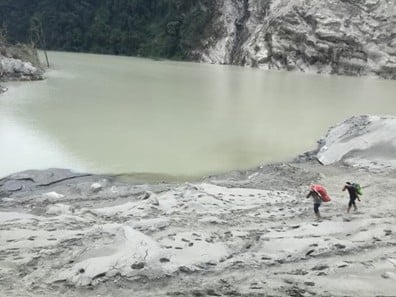
Source: Charisma K. Lepcha
In response, local communities have been uplifting their traditional sustainable food practices, returning to their nearby forests, kitchen gardens, and fields. These trends are largely positive, as they counter consumption of imported processed foods that cause health issues. But more importantly, they strengthen relationships and reinvigorate Indigenous understandings of abundance.
We are two scholars from this region who study Indigenous knowledge systems and cosmologies, and relationships between our communities and the environment. Foodways are a central part of these ways of knowing, and we were both raised in village communities that depended on local food sources as sites of sustenance and relationality.
RECLAIMING SOCIAL AND FLORA ROOTS
Relationality is part of how local foods are gathered, made, and consumed. Regional products can be found in haats, local weekly markets, and the small stores and supermarkets that have begun to appear in the last decade. Relying on plants to thrive requires collaboration and reciprocity between humans and their forests and fields. In the journey of these foods from where they grow to human tables, sites of gathering bring together humans, nonhuman animals, and more-than-human deities, spirits, and forces.
One site of gathering is the forest. Members of the Rong community, the first people of Sikkim, have long histories of forest-foraging for root vegetables, ferns, nettles, bamboo shoots, tubers, and garlic flowers. These traditions have been shared with communities who migrated to Sikkim, including the Lhopo community co-author Kalzang comes from. In Kalzang’s village, which is predominantly Rong with some Lhopo residents, ferns and nettles grow by the side of forested paths that cut across the road into the village.
Figure 3: In western Sikkim, villagers forage lush ferns for meals while also leaving an abundance for others
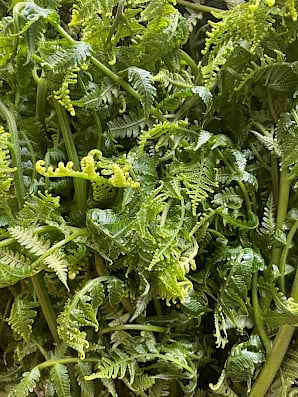
Source: Kalzang Dorjee Bhutia
Local people try not to take more than what is needed, so an abundance remains. People gather stalks from green ferns, the dark green leaves of nettles, and pull and cut bamboo shoots from strong, tall plants as they walk home from the office or after visiting friends—only taking enough for one meal. This concern about leaving plenty for others is not just about humans. It also reflects care for the village’s nonhuman animals, such as cows and goats, and the more-than-human deities and spirits that Indigenous peoples honor through ritual care across different ethnic communities and traditions, including Rong Indigenous cosmology and Buddhism.
Another site of gathering is the kitchen and its garden, where people come together to craft snacks made from local vegetables and fruits. Maize grows widely in Sikkim, and due to the abundance and variety of species, scientists have posited that Sikkim was home to Indigenous varieties— meaning it’s likely not all corn is originally from Mexico and/or Central and South America. One popular snack made from maize, byasu chadung, requires a time-consuming process of soaking white and yellow corn. This mixture is then beaten so it can be molded into a cup shape. Pounding the hard corn mixture takes two people working together and often creates blisters on their hands. When we eat, we give thanks to these people and acknowledge their hard work for us to enjoy the nourishing flavor of byasu chadung soaked in tea. Byasu chadung and other local snack foods are often offered in Buddhist shrines as part of ritual offerings, acknowledging that the many unseen deities of the land also enjoy these flavors.
Figure 4: This photo features local foods from rural Sikkim. At the top (starting on left) are saiyo (made from puffed rice), broken byasu chadung (made from stamped corn), zero (made from rice flour), and at the bottom, honeycomb (made from wheat flour) and kyabse (made from rice flour)

Source: Kalzang Dorjee Bhutia
Figure 5: Local Sikkim chiles, squash, organic cheese (wrapped in a leaf), and buffalo horn vegetables provide a delicious meal

Source: Kalzang Dorjee Bhutia
A final site of gathering is the haat, bustling with vendors selling local organic produce, seasonal fruits, spices, dairy products, and handicrafts along with traders from the nearby city of Siliguri who sell clothes, toys, and household essentials. The Kalimpong haat takes place on Saturdays and Wednesdays, and has a long history of barter and exchange. It provides an alternative to the spread of Jiomart and other online retailers like Amazon and Flipkart. Buyers are friendly with the sellers as they visit the familiar faces week after week. After the pandemic hit in 2020, the Thursday haat started that emphasizes local produce. It has also become a tourist hotspot for visitors who want to buy local produce and sample regional flavors.
Pago reep, a local flower sacred to the Rong people, is one traditional food that can be found at the Kalimpong haat. Known as totola in Nepali, the lingua franca of the region, and scientifically as Oroxylum indicum, the pago reep is gathered as the flowers fall from trees early in the morning. Those who collect it either take it home to eat with rice as a delicacy or sell it at the market. The flower tastes bitter but is of high medicinal value. Even the long pods of pago reep are sold and bought for ceremonial and decorative purposes.
Figure 6: A woman at the Kalimpong haat sells ready-to-eat tapioca along with yeast and fresh vegetables from her harvest.
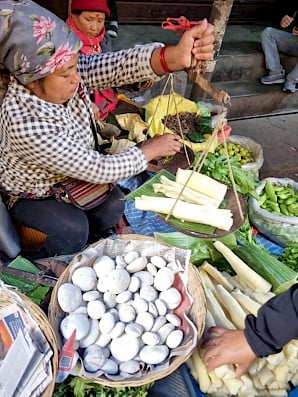
Source: Charisma K. Lepcha
Figure 7: Pago reep, a flower with a bitter taste that carries medicinal value, hangs for sale in the Kalimpong haat, or local market.
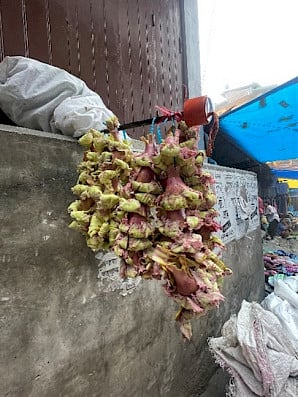
Source: Charisma K. Lepcha
In the economic transaction of producing and consuming this important plant, there is usually an exchange of recipes, sharing age-old wisdom of its medicinal uses and the Oral Traditions attached to this flower. Far more than simply a capitalist exchange of buying and selling, the community supports and recognizes both human and more-than-human food relationships.
Returning to the Past for the Future
The “land of eternal paradise” lies close to our hearts and those of our communities in the region. Rather than viewing resources in an extractive, capitalistic way, we celebrate local food sources. Traditionally, we had enough to share with both humans and nonhumans. When we discuss the benefits of using local foodways now, instead of promoting nostalgia or romanticism for the past, we view our crops and foraging systems as vivid demonstrations of how ancestral knowledge will help us tackle an uncertain future.
Figure 8: In 2024, the National Highway 10 that connects the Sikkim and Kalimpong Himalayas with the Indian plains collapsed due to heavy rains.
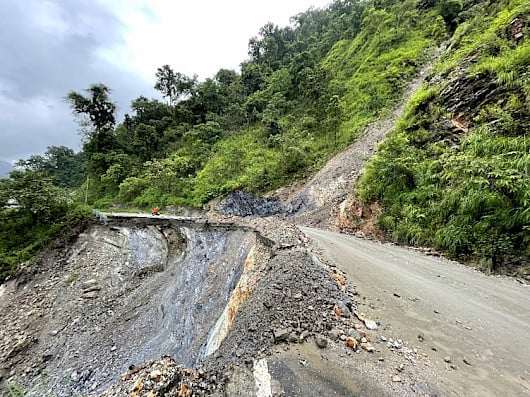
Source: Charisma K. Lepcha
In the past, our forests were ripe with fruits and our kitchens full of harvested crops such as rice. In the Limbu language, sukhim, or new house, invokes the optimism Limbu people had when they encountered the abundance of the land that would provide them with a home. The name for Kalimpong, a region that passed between Sikkim, Bhutan, and British authorities before becoming part of contemporary West Bengal, comes from “Kalenpung.” In the Rong language, it refers to a site of gathering, or “the ridge where we play,” which seems appropriate given the continued importance of the town of this name for its marketplace that brings people together.
Reclaiming Sustainable Sustenance
At the gathering sites of the forest, the kitchen, and the haats of Sikkim and Kalimpong, communities are nourished across dimensions. In an era where mass-produced food is widely available yet the unpredictable impacts of climate change challenge supply routes, practices of forest foraging, domestic food production, and local marketplace exchange are being revitalized as alternatives. These options assert local food sovereignty in the face of capitalism and extraction, even in times of uncertain rain and drought, encouraging ways of being together and remaining nourished that our descendants will still be able to enjoy in years to come.
About the Authors:
Kalzang Dorjee Bhutia is a Lhopo religious studies scholar from west Sikkim in Northeast India. He is a research associate in the Hidden Stories project at the University of Toronto and Princeton University. He studies relationships between human and more-than-human communities in Sikkim and the foodways that connect them. He is also a Non-Resident Senior Fellow at the Centre of Excellence for Himalayan Studies, Shiv Nadar University, Delhi NCR
Charisma K. Lepcha teaches anthropology at Sikkim University in India. Her research interest includes religion, Indigeneity, environment, material culture, and visual anthropology of Sikkim and Kalimpong Himalaya. She has published numerous articles and co-edited The Cultural Heritage of Sikkim and Communities, Institutions and Histories of India’s Northeast. She was a fellow at the Indian Institute of Advanced Studies, Shimla (2018–2019), and a visiting scholar at the Harvard-Yenching Institute at Harvard University in Massachusetts.
Share this on: